
Israel and Palestine
by Troy Herrick
A clash of cultures greets any visitor to the Holy Land. Those who are intent on renewing their faith at the various Biblical sites will undoubtedly be influenced by the political tensions and religious fervor of both Israelis and Palestinians. Not all sites described in the Old and New Testaments are found in Israel. In fact some of the most historic locations are actually within the Palestinian Territory of the West Bank which also includes Jewish settlements. Bethlehem is likely the most frequently visited destination because of its association with Jesus. But there are many other sites of religious and archeological significance that should not be overlooked including Hebron and Jericho which are 30 km south and 24 km east of Jerusalem respectively.
Setting aside the friction between Israelis and Palestinians, you will find that both sides are friendly and welcoming as long as you do not say or do anything that is politically inflammatory or religiously provocative.
Hebron
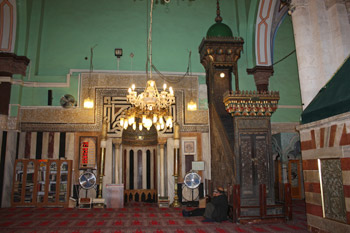 Hebron is the final resting place of the Patriarchs Abraham, Isaac and Jacob and their respective wives Sarah, Rebekah and Leah. Abraham purchased the Cave of Machpelah for use as a family tomb from Ephron the Hittite for 400 silver Shekels (Genesis 23:17). This cave is the second holiest site in Judaism.
Hebron is the final resting place of the Patriarchs Abraham, Isaac and Jacob and their respective wives Sarah, Rebekah and Leah. Abraham purchased the Cave of Machpelah for use as a family tomb from Ephron the Hittite for 400 silver Shekels (Genesis 23:17). This cave is the second holiest site in Judaism.
Abraham, the father of many nations (Genesis 17:5), is just as important to Islam as he is to Judaism. Muslims also revere his burial site and have placed the Mosque of Ibrahimi on top of the sacred cave. The clash of these two great religions has made Hebron one of the most volatile cities in the West Bank.
The weathered gray-white ashlar exterior of this holy building was strangely reminiscent of the Western Wall in Jerusalem. This is not surprising when you realize that both were constructed by Herod the Great over 2000 years ago. In 1188 CE Saladin added a minaret to each of the four corners of the structure but now only two remain.
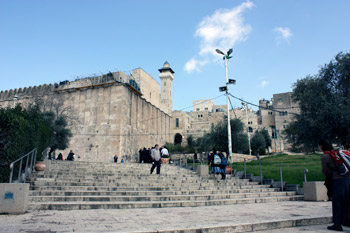 The Tomb of the Patriarchs is the centre of ongoing conflict between Palestinians and Jews. The site is maintained under tight security and segregated into both a mosque and a synagogue.
The Tomb of the Patriarchs is the centre of ongoing conflict between Palestinians and Jews. The site is maintained under tight security and segregated into both a mosque and a synagogue.
Approaching the Mosque of Ibrahimi from the souk, we passed through a turn-style checkpoint and found ourselves in a plaza with Palestinians milling around as they waited to pass through a second security check on our left before entering the mosque. To our right at the far end of the plaza was a metal fence that we could easily move aside had we wished to do so. Israeli soldiers kept a close eye on us from a guard tower while a group of 6 or 8 United Nations Peace Keepers patrolled the street just beyond the metal fence for any sign of trouble.
With so much activity going on, what did we do? We followed our Palestinian guide, Ahmed, through the second checkpoint, up a long flight of stairs and through a door on the northwest side of the building into the mosque.
A short distance inside the door you find yourself looking through a light green latticed double door at the first of six cenotaphs in the building. This is Sarah’s cenotaph (Genesis 49:31) and it is shrouded in a light green embroidered cloth. The location of a cenotaph does not imply that an individual has been interred directly beneath it.
Turning to your left, which is due south, continue into the prayer hall. Inside you find two rectangular cenotaphs with gray and terracotta brown stripes and a dark gray peaked roof. The room is filled with prayer mats. The cenotaph nearest to you is that of Rebekah (Genesis 49:31) and the other is Isaac’s (Genesis 35:29). Continuing along the side wall to the corner of the room, you find an exposed stone with Greek writing on it. This stone is a subtle reminder that this building served as a Christian church from the 3rd to the 7th centuries CE.
Looking toward the opposite corner your eyes become fixed on the richly decorated walnut wood minbar. The minbar, a pulpit, is a high stand with stairs that the Imam ascends in order to address the people. Saladin had this minbar installed in 1191 CE and it is now one of the oldest in the Palestinian Territories and Israel.
Proceed past the minbar and then turn right to walk down the aisle between Isaac’s cenotaph and the wall. Before you enter the next room, look down to your right and find a decorative grate set upon a white marble slab shaped like a flower blossom. This grate covers a shaft leading down to the Cave of the Patriarchs below. A candle burns under the grate but nothing from the interior of the cave is visible. No one has entered this cave since the time of the Crusades.
 Exiting the prayer hall, locate Abraham’s cenotaph (Genesis 23:1-20) on your right. This is the most elaborately decorated monument in the complex. The cloth covering the cenotaph is divided into hexagonal sections, each with a gold embroidered flower blossom at its centre. Abraham’s monument is set within an opening in the wall that separates the mosque from the synagogue next door so that both Muslims and Jews can view it and yet remain segregated from each other.
Exiting the prayer hall, locate Abraham’s cenotaph (Genesis 23:1-20) on your right. This is the most elaborately decorated monument in the complex. The cloth covering the cenotaph is divided into hexagonal sections, each with a gold embroidered flower blossom at its centre. Abraham’s monument is set within an opening in the wall that separates the mosque from the synagogue next door so that both Muslims and Jews can view it and yet remain segregated from each other.
Your tour of the mosque ends here. Exit the building, return to the plaza outside and cross the metal barrier into the Jewish sector. Ahmed directed us to proceed to the Jewish side by ourselves as he would not be permitted to accompany us. Walk the length of the building and find the entrance to the synagogue at the north end. At the bottom of a flight of stairs we were greeted by two Jewish buskers playing hauntingly traditional Jewish music and a group of high school girls.
Climb the steps at the northwest corner of the enclosure and enter the synagogue. The synagogue consists of a number of small rooms presumably designed for both worship and educational purposes.
While touring the synagogue we were able to locate Jacob’s cenotaph (Genesis 50:13) but not Leah’s (Genesis 49:31). Jacob’s cenotaph is housed within its own room and is only visible through a brass-coloured metal door. This cenotaph is shrouded with a light green cloth but I could not get close enough to determine if there was any embroidery or not.
Visitors should note that Jacob had a second wife named Rachel. She was not entombed in the Cave of Machpelah but rather at a site just outside of Bethlehem (Genesis 35:19).
After exiting the synagogue, we enjoyed a delicious lunch with a Palestinian family. This family is one of the few that has managed to retain possession of their residence on the Jewish side of the barrier. The lunch was a feast of traditional roasted chicken and rice. After concluding our meal we left Hebron with a better understanding of the tension between the Palestinians and Israelis.
Jericho
Jericho, the oldest continuously inhabited city in the world has both archeological and Biblical significance. Archeology and the Bible are intricately intertwined here and it is yours to unravel.
You might wonder what would have attracted people to settle in the arid Jordan Valley over the past ten millennia. The most likely reason is that the local spring was the most reliable water source in the area.
The prophet Elisha (2 King 2:21) purified this spring by throwing salt into it. Perhaps this purified water is one of the reasons why Jericho was designated as one of the residences for priests and Levites who were rostered to work in the Temple in Jerusalem.
You can travel to Jericho by taxi from the Palestinian town of Abu Dis just outside Jerusalem. Your journey takes you over the same road that provided the setting for Jesus’ Parable of the Good Samaritan (Luke 10:25-37), although the highway was not paved back then.
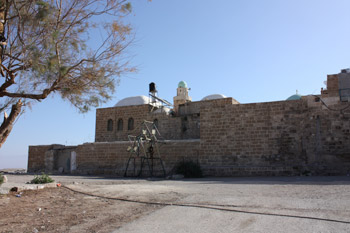 En route to Jericho, you pass by An Nabi Musa, a former caravanserai where Muslim travelers could rest for the night as they traveled to Mecca for the Hajj. The caravanserai houses a mosque dating to 1269 CE which was built by the Mamluk Sultan Baybers. Inside the mosque you find a second room containing a cenotaph covered in a silky green cloth embroidered with gold Arabic script. Muslims believe that this is the final resting place of Moses whose bones were removed from Mount Nebo in neighbouring Jordan by Saladin. Jews and Christians believe that Moses still rests on Mount Nebo to this day (Deuteronomy 34: 5-6).
En route to Jericho, you pass by An Nabi Musa, a former caravanserai where Muslim travelers could rest for the night as they traveled to Mecca for the Hajj. The caravanserai houses a mosque dating to 1269 CE which was built by the Mamluk Sultan Baybers. Inside the mosque you find a second room containing a cenotaph covered in a silky green cloth embroidered with gold Arabic script. Muslims believe that this is the final resting place of Moses whose bones were removed from Mount Nebo in neighbouring Jordan by Saladin. Jews and Christians believe that Moses still rests on Mount Nebo to this day (Deuteronomy 34: 5-6).
Resuming your journey, your taxi must pass through a Palestinian checkpoint before entering Jericho, a city administered by the Palestinian National Authority. After Diane and I presented our passports we were permitted to travel without restriction.
Driving through the sedate town to the site of ancient Jericho, our driver, Mohammed, quickly stopped to point out the gnarled Zacchaeus Sycamore with an arched cave-like opening in its trunk. Tradition holds that a rich tax collector named Zacchaeus climbed this tree in order to see Jesus as he passed by (Luke 19:1-4). You may find it difficult to believe that this tree is actually 2000 years old however.
 After a few minutes we continued on to Tell es-Sultan, the site of ancient Jericho. Just thinking about this city conjures up images of Israelites marching, the sound of trumpets and walls falling down (Joshua 6:1-21). What you find is a 15 metre high mound (“Tell” in Arabic) of earth covering approximately 2.5 hectares. Archeologists have sliced trenches deep into this mound and uncovered 23 successive settlements built atop each other. The oldest layer dates back to 8000 BCE. A number of signs highlight the structures found within each trench.
After a few minutes we continued on to Tell es-Sultan, the site of ancient Jericho. Just thinking about this city conjures up images of Israelites marching, the sound of trumpets and walls falling down (Joshua 6:1-21). What you find is a 15 metre high mound (“Tell” in Arabic) of earth covering approximately 2.5 hectares. Archeologists have sliced trenches deep into this mound and uncovered 23 successive settlements built atop each other. The oldest layer dates back to 8000 BCE. A number of signs highlight the structures found within each trench.
Discoveries include an 8 meter high round tower constructed of stones to a diameter of 7.6 meters which dates to 7000 BCE. This tower is attached to the interior of a 4 meter thick defensive wall. Twenty-two narrow steps made from dried mud form the world’s oldest spiral staircase. Another location features a Canaanite Palace from the second millennium BCE and a royal tomb.
 The slope of one of the “Tell” layers dating to the Middle Bronze Age (1650-1550 BCE) was fortified by an earthen embankment with a mud brick wall at its summit. A large retaining wall at the base of the embankment was constructed from Cyclopean stones. This Cyclopean wall also supported a second mud brick wall at a height of 8 meters. This second mud brick wall, believed to have been about 70 centimeters thick, was uncovered in a collapsed state, possibly having been leveled by an earthquake. The nearby Jordan Valley is known to have a fault line running through it and earthquakes have been recorded at various times in history.
The slope of one of the “Tell” layers dating to the Middle Bronze Age (1650-1550 BCE) was fortified by an earthen embankment with a mud brick wall at its summit. A large retaining wall at the base of the embankment was constructed from Cyclopean stones. This Cyclopean wall also supported a second mud brick wall at a height of 8 meters. This second mud brick wall, believed to have been about 70 centimeters thick, was uncovered in a collapsed state, possibly having been leveled by an earthquake. The nearby Jordan Valley is known to have a fault line running through it and earthquakes have been recorded at various times in history.
There is much debate about when Jericho fell to the Israelites. Archeologists place the dates anywhere from 1550 to 1200 BCE. Therefore these defensive walls appear to be the most likely candidate for those destroyed by Joshua’s army.
After the late Bronze Age, the importance of the Tell site as a city declined significantly. Five centuries before Jesus, a new site for the city had already been established approximately 1.6 km southeast of the present-day mound.
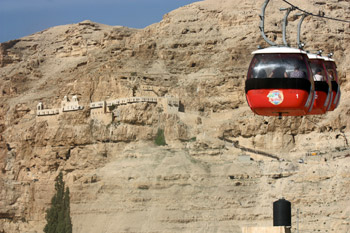 Exiting the archeological site, walk a short distance to the cable car and ride it up to the Monastery of Temptation set on the side of a nearby mountain. Administered by the Greek Orthodox Church, this monastery is situated on the traditional site where Jesus fasted for 40 days in the wilderness while being tempted by Satan (Matthew 4:1-11, Luke 4:1-13 and Mark 1:12-13).
Exiting the archeological site, walk a short distance to the cable car and ride it up to the Monastery of Temptation set on the side of a nearby mountain. Administered by the Greek Orthodox Church, this monastery is situated on the traditional site where Jesus fasted for 40 days in the wilderness while being tempted by Satan (Matthew 4:1-11, Luke 4:1-13 and Mark 1:12-13).
Upon reaching the top of the cable car line, several flights of stairs still remain before you reach the monastery entrance. At the time of our visit, we were greeted by one of the two monks who reside on site. The other was quite elderly and did not appear to be too mobile. These monks cap off a long history that spans more than 1000 years of residence here.
 Inside the monastery, you pass down a long hallway that is open to the sky. This hallway runs along the sheer rock face where several caves have been hollowed out. The outer wall is a row of doors that open into rooms that have been cantilevered from the cliff.
Inside the monastery, you pass down a long hallway that is open to the sky. This hallway runs along the sheer rock face where several caves have been hollowed out. The outer wall is a row of doors that open into rooms that have been cantilevered from the cliff.
The interior of the monastery chapel is adorned with a number of icons. One pillar features St. Helena and Constantine. There are also two recessed areas with frescos of Jesus and Mary while a side wall depicts Jesus’ baptism (Matthew 3:13-17). Climb the stairs in the chapel and you will find a stone that tradition holds is where Jesus sat during one of his temptations.
Exiting the monastery, you may wish to enjoy the panoramic view of the Jordan Valley and Dead Sea from your mountain perch. You might be able to ask one of the monks if he would point out the traditional site of Jesus’ baptism at Qasr El-Yahuda which is only about 8 km away. This is also the traditional site where the Israelites first entered the Promised Land (Joshua 3:14-17). Present day Qasr El-Yahuda is situated on an Israeli military base so your Palestinian taxi driver cannot bring you there. You will have to be satisfied with seeing it from a distance.
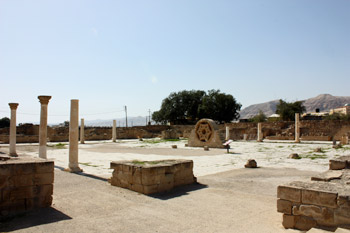 After descending by cable car, your next destination is Hisham’s Palace which was built by Caliph Hisham Bin Abdul Malik (724-743 CE) but never completed. The construction site was later leveled by an earthquake in 749 CE. Several layers of limestone blocks define all that remains of a once two-story building that served as a winter palace. The rooms of the palace were set around an inner portico and each corner of the structure had a cylindrical tower. A large hexagonal limestone star, cut from a single block of limestone, is believed to be all that remains of an upper window from this palace.
After descending by cable car, your next destination is Hisham’s Palace which was built by Caliph Hisham Bin Abdul Malik (724-743 CE) but never completed. The construction site was later leveled by an earthquake in 749 CE. Several layers of limestone blocks define all that remains of a once two-story building that served as a winter palace. The rooms of the palace were set around an inner portico and each corner of the structure had a cylindrical tower. A large hexagonal limestone star, cut from a single block of limestone, is believed to be all that remains of an upper window from this palace.
The site also features the remnants of a mosque that was set within an octagonal pavilion. Coincidentally the Muslim call to prayer sounded in the distance as we visited this room.
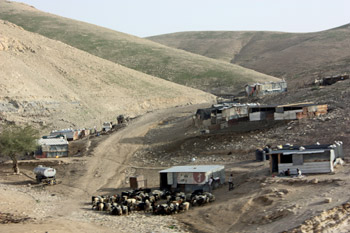 Just north of the palace you find the remains of a bath complex. The reception room features a beautiful mosaic on the floor depicting the “Tree of Life”. Three gazelles graze at the bottom of the fruit tree and a lion is ready to pounce on one of them. The bathing rooms, set along the northern wall of the bath house, were heated by hypocausts.
Just north of the palace you find the remains of a bath complex. The reception room features a beautiful mosaic on the floor depicting the “Tree of Life”. Three gazelles graze at the bottom of the fruit tree and a lion is ready to pounce on one of them. The bathing rooms, set along the northern wall of the bath house, were heated by hypocausts.
When you complete your visit to Hisham’s Palace, return to Abu Dis. Along the way, you can still see Bedouin tending sheep on the hillsides or guiding a colorfully decorated camel along the roadside. A once-nomadic people, many Bedouin have settled down and now live in their own homes, which would not appear to be out of place in a shanty town. They represent a time when life was much simpler; and perhaps thinking of simpler times might help to diffuse some of the tension that now permeates the West Bank.
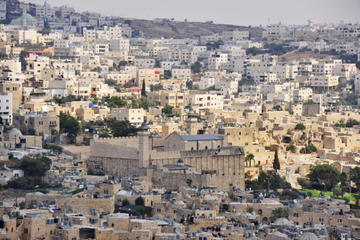
Hebron Day Trip from Jerusalem: Israeli-Palestinian Sites
If You Go:
♦ Do not use a rental car when visiting Hebron and Jericho. Cars with Israeli licenses will not be welcome in these cities. Alternatively cars with Palestinian license plates will not be welcomed into Jewish areas.
♦ There is presently no direct service from Jerusalem to Jericho. You must use bus #36 at the Arab bus station outside the Damascus Gate of Jerusalem’s old city to travel to Abu Dis. In Abu Dis, hire a taxi to bring you to Jericho and drive you around. The driver should also wait for you as you visit sites. You will have to negotiate a price for the taxi.
♦ Hebron should be visited with a Palestinian tour company. You can visit both Hebron and Jericho with Green Olive Tours.
♦ Always have your passport with you. You will subject to Israeli security checks when you cross wall that separates the West Bank from Israel.
♦ Women should cover their heads when they enter a mosque. Scarves are provided at the mosque entrance. Men should cover their heads when they enter a synagogue. People should also remove their shoes when they enter a mosque.
♦ An Nabi Musa is situated about 11 km south of Jericho and 20 km east of Jerusalem. Admission to the mosque is free.
♦ Tell es-Sultan (ancient Jericho) is approximately 2 km north of the present city. Admission to Tell es-Sultan was 10 shekels at the time of our visit.
♦ The cable car ride up to the Monastery of Temptation cost 55 Shekels at the time of our visit. Alternatively you can also walk up to the monastery using a steep path. Photography is not permitted inside the chapel.
♦ Hisham’s Palace is approximately 5 km north of modern Jericho. Admission was 10 Skekels at the time of our visit.
♦ Remember to use sunscreen and a hat when visiting the sites. Jericho is situated in a desert so bring plenty of drinking water if you plan to do a great deal of walking.
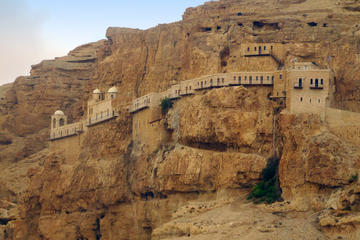
Private Day Tour Jericho and Dead Sea from Jerusalem Hotels
About the author:
Troy Herrick is a freelance travel writer who has traveled extensively in North America, the Caribbean, Europe and parts of South America. His articles have appeared in Live Life Travel, International Living, Offbeat Travel and Travel Thru History Magazines.
Photographs:
All photos are by Diane Gagnon, a freelance photographer who has traveled extensively in North America, the Caribbean, Europe and parts of South America. Her photographs have accompanied Troy Herrick’s articles in Live Life Travel, Offbeat Travel and Travel Thru History Magazines.
Synagogue at the Tomb of the Patriarchs
Prayer Hall in the Mosque of Ibrahimi
Tomb of the Patriarchs – from the Jewish side
Abraham’s Cenotaph
Caravanserai at An Nabi Musa
Tell es-Sultan – round tower
Tell es-Sultan – Cyclopean Tower
Monastery of Temptation – cable car at Jericho
Monastery of Temptation – rock on which Jesus sat
Jericho – Hisham’s Palace
Bedouin settlement



